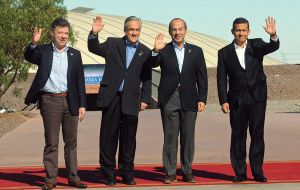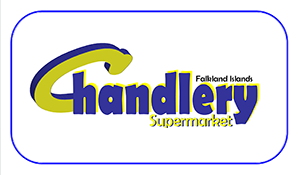MercoPress. South Atlantic News Agency
The Pacific Alliance, yet another bloc in Latin America
 The four Pacific presidents celebrate the Alliance
The four Pacific presidents celebrate the Alliance The newly-formed Pacific Alliance bloc seems more like a political club to counterbalance the Atlantic-facing, Brazil-led Mercosur group. However, the bloc accounts for 30% of India’s trade with Latin America. Can India engage the group so it is not left out from their Asia focus?
By Ambassador R. Viswanathan (Former Ambassador to Argentina, Uruguay and Paraguay)
The Presidents of Chile, Colombia, Peru and Mexico signed an agreement establishing a regional group called as “Pacific Alliance” in their summit meeting on 6 May at the Paranal observatory in the Atacama desert of Chile. The Presidents of Costa Rica and Panama, who attended the summit as observers, have expressed interest in joining this new bloc. The Pacific Alliance idea was initiated by Alan Garcia, the then President of Peru in April 2011 in the first summit he had convened. It took two more summits to give shape and finalize this new regional integration.
Chile’s President Sebastián Piñera, in his speech at the signing ceremony said, “[the] Pacific Alliance is much more than a Free Trade Agreement. It is an Agreement of deep and broad integration that involves the exchange of goods, services, investment, people, and at the same time is committed towards physical, infrastructure and energy integration.”
Colombian President Juan Manuel Santos described the new bloc as “one of the most significant processes towards integrations that have taken place in Latin America.” The Alliance is starting with free movement of goods and people by the end of 2012. The bourses from Lima, Bogotá and Santiago joined together and formed in 2011 an integrated exchange known as Mila, which will soon have Mexico’s main stock exchange too.
The new economic bloc has a combined population of 204 million (36% of Latin American population), GDP of 1.7 trillion dollars (35% of region’s GDP) and global trade of 1045 billion which is half of the region’s global trade.
Chile, Colombia and Peru are already part of the Andean Community, which is one of the oldest and best institutionalized among the five Latino regional blocs, namely, Mercosur, UNASUR, SICA and NAFTA. The Andean Community , which has its own secretariat and development bank, was wrecked by Venezuelan President Chavez who pulled Venezuela out of this group in 2006 as part of his personal fight against the then Colombian President Alvaro Uribe. The exit of Venezuela was followed by the entry of Chile in the group.
However, the Andean Community’s future remains uncertain because of the political incompatibility between the leftist-led Bolivia and Ecuador on the one hand and the right of centre-led Colombia and Chile on the other side. Mexico is part of NAFTA and 80% of its trade is with US and Canada.
The four member countries of the Alliance have some common features: All four of them have investment grade markets. They are more open economies, outward looking and are keen to diversify their trade and economic partnerships. Chile and Mexico have signed the maximum number of FTA (Free Trade Agreements) with other countries around the world. Peru and Colombia are following their examples. All four of them have FTA partnerships with US.
There is also political convergence between the four members of the Pacific Alliance. Chile, Colombia and Mexico have centre-right governments. The Peruvian President Ollanta Humala, although a leftist, has emerged as a pragmatist, following the example of Brazil’s Lula da Silva.
But there is no great complementarity in trade. The intra-alliance trade is insignificant and less than 3% of their combined global trade. Most of their trade is with external partners. In contrast, Mercosur countries do significant trade (20% of their trade) with each other. Another obstacle for integration is the fact that geographically they are not contiguous.
The Pacific Alliance has not spelt out if they plan to set up institutions such as secretariat and common parliament. Nor have they set any time table for a customs union or common external tariff.
It seems that the Pacific Alliance bloc is more of a political club. It is perceived as a new force to counterbalance the Atlantic-facing and Brazil-led Mercosur group ruled by leftist Presidents. Besides forming Mercosur Brazil had taken the initiative to create the Unasur group in 2008 bringing together all the twelve countries of South America. They went further and created CELAC ( Community of Latin American and Caribbean States) in 2010, in a clear challenge to the Washington-based and US-led Organisation of American States (OAS).
Apart from asserting their autonomy through these integrations, the South American leftist Presidents managed to defeat the US proposal to form FTAA (Free Trade Area of the Americas) under which the whole hemisphere was to be made as a common market in which sub-regional groups such as Mercosur were to be dissolved. The climax of this Latin American assertion of independence and refusal to be the US backyard was demonstrated dramatically at the Mar del Plata Summit of the Americas in 2005 when the US stood completely isolated in the hemisphere and found its FTAA proposal shred to pieces. With this background, the US is seen as the hidden hand behind the formation of the Pacific Alliance to divide the region, hobble the growing Latin American autonomy and counter the rising leadership profile of Brazil.
The rivalry of the new alliance with Mercosur was let out by President Calderon of Mexico, who mentioned in his speech, “Even when we are less in population and in the size of our economies compared to our brothers from Mercosur, we export double in volume and value than Mercosur. We have an extraordinary potential”.
However the Peruvian and Colombian Presidents downplayed the Mercosur rivalry saying that Pacific Alliance was not directed against any other group.
One of the stated objectives of the Pacific Alliance is to increase trade with Asia. The Alliance is planning a FTA with ASEAN. Chile and Peru have signed FTA with China, Japan and Korea, while Colombia and Mexico are in the process of negotiating FTA with China, Korea and Japan.
India does not have FTA with any member of the Pacific Alliance except for a PTA with Chile. Indian exports therefore, face disadvantage in the markets of the Pacific Alliance vis-à-vis those who have FTAs. It is, therefore, imperative that India should take the initiative to sign PTAs or FTAs with members of the new Alliance.
India’s trade with the Pacific Alliance in 2011 was 7.7 billion dollars of which exports were 3.1 billion and imports 4.6 billion. The trade with Pacific Alliance countries is 30% of the total trade with Latin America. There is potential to double India’s exports to the growing markets of the new Alliance in the next three years. Chile and Peru are important sources of copper and other minerals while Mexico and Colombia are sources of crude oil for India. Although Brazil is the most important strategic partner in Latin America, India should consider engaging the Pacific Alliance (keeping in mind Brazilian sensitivity) so that it is not left out from their Asia focus.
R. Viswanathan, who has just retired as Ambassador to Argentina, is an expert on Latin America. His email: rv@rviswanathan.com
This article is part of the ‘Ambassadors’ views’ section, a collection of articles featuring eminent Indian diplomats.




Top Comments
Disclaimer & comment rules-

-

-

Read all commentsThe new world is Asia !
Jun 12th, 2012 - 08:25 pm 0Im not so sure about that, the signs are not good coming from China and India right now. Boom boom boom then bust.
Jun 12th, 2012 - 10:08 pm 0I agree Max, new world is Asia.
Jun 12th, 2012 - 10:48 pm 0Commenting for this story is now closed.
If you have a Facebook account, become a fan and comment on our Facebook Page!